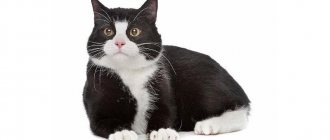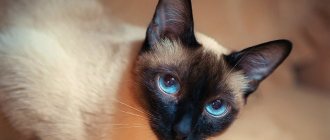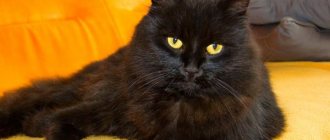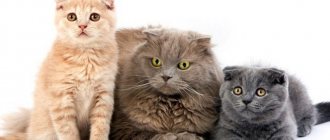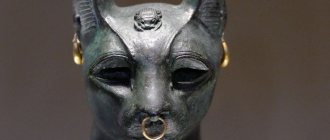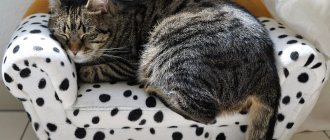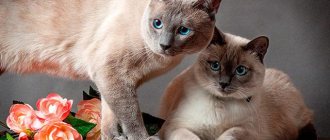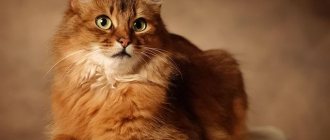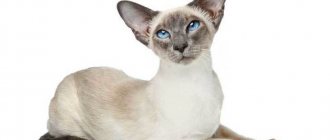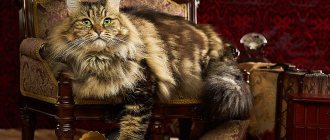Bi-colored kittens with black and white markings are also called tuxedo or piebald cats. Some people mistakenly believe that tuxedo cats are a special breed.
Tuxedo refers to the distinctive markings on the coat that make it look like someone is wearing a formal tuxedo. Mixed breed domestic cats, also called moggies, may also have black and white markings.
Black is a common coat color in cats because it is the dominant gene. Black and white cats have a white spot gene that prevents colored melanocytes from migrating into these areas.
Here are 10 popular types of cats that can have black and white coats, as well as other potential coat colors and markings.
Maine Coon
The Maine Coon is one of the largest cat breeds and is known for its incredible affection. Combined with their distinctive appearance and shiny coat, they are one of the most popular breeds around the world.
Maine Coons are usually tabby, but they come in a variety of colors and patterns, including black and white. These cats usually get along well with all family members, including respectful children and dogs.
They are loyal and affectionate, but not too needy. Maine Coons are known to be expert mousecatchers and may not be suitable for families with small, furry pets.
Colorpoint: a variety of beautiful colors
Translated from English, the name of this group means “colored tip.” Indeed, the animal has a light body, and the tips of its ears, paws and muzzle have a darker shade. Individuals of this group can be identified by darkened areas on lighter fur. Siamese and Himalayan cats are considered typical representatives of this group.
To understand the characteristics of the color, it is useful to know the principle by which these very names are constructed: primary color + pattern (if any) + the word “point”. For example, seal point (brown on light), tabby point.
Some cat breeds have their own colorpoint name. Thus, Persians with a Siamese color are usually designated as Himalayan. Burs have their own line of names. Professionals might simply say lilac, sable chocolate color. However, in relation to this breed there will be not a solid color, but a color point.
Cornish Rex
The black and white Cornish Rex impresses with its famous dense, curly rows of coat; wide set large ears; and a slender physique. They are sometimes called greyhounds from the cat kingdom.
Energetic and sociable, this breed thrives in company. The Cornish Rex is an intelligent cat that can be taught many impressive tricks, some of which can help as therapy animals.
How to care
Caring for black and white cats is practically no different from caring for other pets. True, experts note that such animals are very clean and love bathing and brushing their fur. It is important to raise a kitten correctly, without being too strict towards it, since otherwise the pet may grow up withdrawn and unsociable.
There is a popular belief that black and white cats are a kind of living talisman that attracts happiness, luck, success and financial well-being to the house.
Manx cat
Like the Cornish Rex, the Manx is dog-like. They are usually playful, sociable, even-tempered and energetic. Manx cats are also intelligent and highly trainable.
This breed is usually tailless, but they sometimes have a short stump. They come in a variety of coat colors, including black and white. This short-haired variety can shed heavily, and with their rounded and shorter back, they may be more susceptible to spinal problems. These cats are also famous for their mousecatching skills.
Scottish fold
Scottish fold cats are extremely gentle and charming. Their defenselessness and somewhat childish habits are touching.
The saturation of the iris of these beautiful cats with blue eyes is determined not only by the number of pigment granules in the retina. It largely depends on the lighting and coat color. For comparison: eyes always look brighter against a dark background than against a light one. The range of colors is quite wide, starting with sky blue and ending with sapphire blue. The final color is established closer to one year, and the most saturated shade appears at two years.
Munchkin
This breed gets its name from its shorter than average legs, which are due to a natural genetic mutation. Munchkins come in a variety of color combinations, including black and white.
Due to their short legs, the Munchkin may need extra help when it comes to grooming hard-to-reach areas. The debate revolves around the ethics of continuing to breed this cat with its abnormal mutation and the potential correlation between specific health problems and this body shape.
Content
Keeping Russian cats is no different from proper care, but each breed has its own nuances. Some breeds require a predominance of certain nutrients in the diet, while others require rinsing when caring for their eyes. Fluffy and semi-long-haired animals require attention to their fur: combing and periodic water treatments. Individual animal care. It depends not only on the breed, but also on the following factors:
- age;
- sterilization/castration or lack thereof;
- past illnesses.
Nutrition
Meals must be regular and balanced; you cannot feed the animal exclusively with dry food. Food must be nutritious and energetically valuable. The diet should contain a lot of protein (found in meat and milk), 20% fat is allowed, and there should not be a lot of carbohydrates. The diet of spayed/neutered animals differs from the diet of ordinary cats. So, it must contain minerals and vitamins pre-selected by a veterinarian.
The diet should include the following components:
meat – rich in amino acids and nutrients; Do not eat fatty meats like pork;
fish – rich in phosphorus, calcium and protein;
dairy products should be given with caution, as some breeds are lactose intolerant; Cereal porridge mixed with vegetables will be useful; to keep the animal interested, you should mix in meat or fish.
Hygiene
Cats are excellent at maintaining personal hygiene, but some breeds require special care. Cats with longer hair require daily brushing and occasional bathing. The ears require attention: they should be periodically inspected and cleaned, and ear drops should be instilled to prevent mites and ear diseases. You should wash your eyes with a moistened cotton pad in the morning.
Oriental shorthair cat
The Oriental Shorthair is often confused with its Siamese cousin and is therefore a separate breed. Unlike Siamese, these cats have green eyes and come in a variety of colors and patterns, including black and white.
Like the Siamese, the Oriental Shorthair tends to be inquisitive, chatty, and even-tempered. While no cat is truly hypoallergenic, this breed is known to produce less Fel D1 protein, which can cause allergies. They have short, single coats, which means these cats sense the cold and prefer a cozy, draft-free home.
Javanese
The breed of Oriental longhaired cats has all the characteristics of the general standard: an elongated body, slender limbs, a wedge-shaped head and huge pointed ears. The not deep-set blue eyes of these beautiful cats are placed closer to the nose, successfully harmonizing the wedge line of the ears and head.
The color of representatives of this breed can include various point combinations. The Javanese is characterized by the presence of a long, silky plume on a slightly shaded tail, shaped like a fluffed ostrich feather.
Persian cat
While the pure white Persian is often the most photographed and highly prized variety of this popular breed, they also come in other colors, including black and white.
There is no mistaking this breed for their long, thick coat; large bright eyes; and crumpled faces. Their popularity also stems from their laid-back, low-energy, and cozy nature.
They are not known as one of the smartest or most trainable cats. The Persian's long, shiny coat requires daily grooming. It tangles easily and causes discomfort if neglected.
Burmese
Burmese cats are the proud owners of luxurious fur, decorated with a characteristic pattern in the form of a diamond-shaped “mask” and “gloves”. White paws add delicate notes to the image, and bright blue eyes are a spectacular addition.
Cats of this breed have a medium-sized body, short limbs, and a wide round head. The Burmese's faces are heart-shaped. This gives them a special charm. The length of the fur covering the body is uneven. It is thickest in the neck area, forming a kind of “lion’s mane.”
Scottish fold cat
Known for its small, curled ears, the Scottish Fold looks quite mischievous. These cats are usually not mischievous at all.
Known for being laid-back and friendly, Scottish Folds typically do well around other pets and respectful children.
This breed is at greater risk of developing degenerative joint disease, which can affect the development of cartilage and bones.
Their thick coat requires regular grooming to avoid problems with fur balls. The black and white combination is just one of the many colors the breed can have.
Interesting Facts
There are several interesting facts about black kittens with white paws and spots on their bodies. For example, the two-color color of cats was considered a defect for a long time, and only at the end of 1969 were they allowed to participate in exhibitions.
These animals are independent and self-sufficient, thanks to which they are able to survive without outside help. They are resistant to stressful situations and are never the first to show aggression. These animals love people and calmly get along with them under the same roof.
Black and white cats are unusually beautiful pets that are distinguished by their attractive two-tone color. People who want to get such pets should familiarize themselves with their main features and breeds in advance.
Siberian cat
Siberian cats have a very thick, semi-long-haired, triple-haired coat. They need this fur to survive in the frosty forested subarctic regions of Siberia. The breed is growing in popularity due to its affectionate, playful nature and striking appearance. Siberians are active and smart and need communication so as not to get bored.
Their coat is not prone to tangling, but sheds heavily every two years. The brown tabby is the most common pattern of Siberians, although they come in a variety of colors and patterns, including black and white.
Turkish Angora
The elegant, long-haired Turkish Angora was once associated only with white skin color. They are still most often found in this color and come in many other variations, including black and white.
Turkish Angoras are generally best suited to family homes, where they spend most of the day. Sociable and affectionate, they need a lot of attention and enrichment.
They are more active than regular cats and can become mischievous if they get bored. Unlike most cats, this breed often loves to swim and play in the water.
Varieties of black and white color
All bicolor cats have a different appearance due to the variability in shape, size and location of spots, as well as the main color. There are 3 main types of colors for such cats - harlequin, van, bicolor. These colors are found in representatives of various breeds - from Britons and Maine Coons to Sphynxes and Bobtails. In some breeds, two-color coloring is established as a standard.
Harlequin cat
The harlequin color got its name in honor of the famous character - cheerful, but a little lazy, dressed in snow-white clothes with multi-colored patches. Such “patches” are also found on cats’ fur coats, and they create the impression of energy, frivolity and playfulness.
Harlequin cat
The harlequin coloring is characterized by a basic milky background on which colored spots are located. They can have the shape of a circle, oval, stripe or any other. The correct outlines of spots located symmetrically are especially appreciated. With the harlequin color, darker areas are located on the face, ears, and also on the back, where they do not join into one stripe, but are interrupted. Another sign of this color is the absence of snow-white hairs inside the dark spots. In the case of the British harlequin color, the tail is completely darkened.
In addition to the black and white version, the harlequin color can be snow-white with red, cream, gray, brown, and red markings. The combinations can be any that are acceptable for a particular breed.
It is important that the colored markings occupy approximately 1/5 of the entire coat. If there are fewer or more of them, most likely it is a van or bicolor
There are not only purebred cats, but also mongrel cats with the harlequin color.
Breeders wishing to breed kittens of this color should be prepared for unpredictable results. It is impossible to predict in advance the color and location of spots on an animal’s fur. To obtain offspring with the “harlequin” coloring, you should choose parents of the desired color or a black and white cat and a cat with a tortoiseshell coat. In this case, it is possible to give birth to kittens that are not only two-colored, but also have other shades of fur.
With this color, of interest is not only the location of the spots on the cat’s body, but also the pigmentation of the nose, paw pads, and lips. These body parts can be either black and pink or entirely black or pink. In such animals, heterochromia (eyes of different colors) is more common than in others. If one half of the muzzle is snow-white and the other is black, there is a high probability that the animal will have blue and green eyes, respectively.
Bicolor options
The bicolor color is characterized by a dark coat background, on which there are several milky spots. Often such cats have light-colored paws with a small splash of black, a snow-white spot in the chest area, and one or more white patterns on the back, sides or head. With bicolor colors, light areas occupy from 1/3 to 1/2 of the surface of the cat's coat. If a cat has a predominantly black coat with small milky patches, it is not bicolor. There are several options for “two-color”, when light spots on a black background are located on certain parts of the body:
- with snow-white “gloves” (on paws);
- with a milky “medallion” (with a mark on the chest);
- “tuxedo” (with snow-white spots around the chest and paws, possibly on the head);
- “mitted” (with “medallion”, “buttons”, “gloves”);
- "cap" and "saddle" (a cap-like marking on the head and around the tail extending to the upper back of the back);
- Seychelles (black spots on the head, back, paws, and the tail is completely dark);
- magpie (spots are located on the head and back).
People have superstitions regarding the color of a domestic cat's fur coat. It is believed that pets wearing snow-white socks attract wealth to the home. Black and white pussies convey to their owners a philosophical outlook on life and protect them from unnecessary worries. Animals of this color are preferred by people with a sober outlook on life, who are not inclined to build castles in the air.
Van color
Van color cat
The Van coloring is characterized by a basic snow-white background (5/6 of the surface of the coat), on which there are charcoal-colored spots (usually a couple of marks on the face, the tail is completely black)
It is possible to have 1-3 spots on the body or paws, if we are not talking about the Turkish Van breed (in this case, it is important to meet clear criteria - two marks on the muzzle, separated by a light “flame”, and a pigmented tail)
